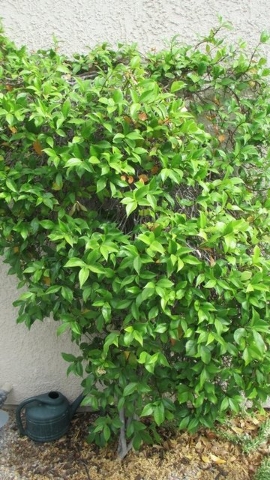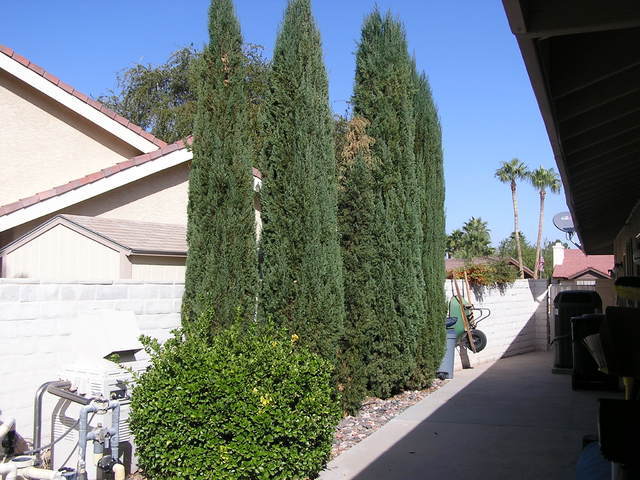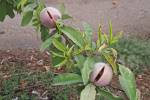Star jasmine should recover from exposure to full sun
Q: My next-door neighbor cut down large pine trees that shaded my wall of star jasmine two days ago. Is there any point trying to rig a shade cloth to get through the rest of the summer hoping they can “harden off” to full sun or should I basically pronounce them dead and start the grieving process now?
A: Star jasmine can handle full sun if it’s planted in good soil. But you are right, it will probably go through some shock to have it this exposed to the hot sun at this time of year.
These plants will probably have some leaf scorch and some dieback as they transition to full sun. But I think it will rebound. You may have to cut the damaged parts back, fertilize it in October and let it regrow. At this point, I would wait and see what happens.
Plant health has a lot to do with how plants handle hot weather. Plants that are not as healthy will have more difficulty during hot weather than plants that are in good health. In a contrast to this, plants that are not as healthy can grow in protected environments and still look good.
I would encourage you to buy some decent compost and spread about an inch layer at the base of these plants and water it in. This should improve their health. The best compost for this I found is at Viragrow in North Las Vegas available in bulk bags. Soil improvement will go a long way in improving plant health and their ability to withstand adverse conditions.
Because of the high light intensity and warmer temperatures, they might begin to use more water in this location. I don’t necessarily think you need to apply water daily in this spot but you may have to increase the volume of water 20 or so percent and maybe add an extra day of watering.
Try adding this water with a hose first but avoid daily watering if you can. Watering daily might create some problems for these plants if the soil doesn’t drain very well.
If there is no surface mulch surrounding these plants on the soil surface then put down a 3- to 4-inch layer. Wood mulch is better than rock mulch for soil improvement. You can get wood mulch free from the university orchard in North Las Vegas, which is 100 yards east of the corner of Horse Drive and North Decatur in Aliante any Tuesday, Thursday or Saturday morning.
Q: I have a butterfly bush that is struggling. It looked wonderful this past spring but now the leaves and blooms are much smaller. There are many leaves turning black. The bush has full sun and gets watered regularly. Do you know what the problem might be?
A: Check for grubs (worms) eating the roots. This is a common problem on butterfly bush this time of year. Use a liquid insecticide as a soil drench to wash the roots and kill the grubs or use granular insecticide and watered into the soil. Look for one that is for grubs at your nursery or garden center.
Q: For several years my saguaro has been turning brown slowly but the process sped up this year. I have two others, but neither of them has problems and seem to be completely healthy. I really don’t believe I am overwatering it but it is a possibility
A: The last time I saw this kind of browning on the surface of a saguaro is in a landscape where they were wrapping it each winter in an attempt to protect it from winter cold damage. They used burlap.
It caused a lot of surface disease problems on the cactus because of a lack of air circulation. They finally stopped doing that, but the damage was already done and the surface of the cactus had a lot of brown damaged areas.
I hope you are not wrapping it during the winter. If you are, stop it. Let it breathe and take your chances. I know they are expensive.
Make sure that water is applied to the surface of the soil surrounding out to a distance of 6 to 8 feet and water is not spraying the trunk. Do not water too often. Water deeply in these areas about every two to three weeks. I would rather see it watered every three weeks rather than two weeks and actually three weeks is really too often.
These plants store water in their fat bodies and can live on this stored water for a long time. When water is present in the soil after a rain or irrigation the roots absorb it like a sponge, very quickly and that fat body swells up and expands like an accordion. That’s why it’s ribbed.
Don’t wrap it in the winter time and water it deeply and not very often.
Q: I removed two Italian cypress trees, which was harder than I imagined, especially the stumps. When is a good time to replace this tree and what size hole does it require? Does the soil need any special preparation prior to planting?
A: I can imagine that was a very difficult job removing Italian cypress. Probably the easiest way to do it is to cut it off and rent a stump grinder and grind out the stumps. The stump grindings mixed with soil makes a fabulous mulch.
The best time to replant is in the fall months, but the problem is plant selection. There is usually not much to pick from. The best stuff is gone and the nurseries don’t want to be stuck with anything through the winter so availability of plants from wholesalers is limited to stuff that didn’t sell. But you can still find things if you’re willing to look around.
An alternative to Italian cypress is the Skyrocket juniper. It is hard to find but stays narrow like Italian cypress yet doesn’t grow as big. I have never seen any available in the Southern states. They used to be popular 30 or 40 years ago.
You should not have a problem planting in the same holes if the Italian cypress was healthy. Dig a hole three to four times the diameter of the container it comes in. If the soil from these holes already has quite a bit of organic matter in them (the soil will be dark brown), then don’t add anything to the soil. Otherwise, mix the soil you take from the hole 50/50 with compost.
Q: Last year I purchased a home with four mesquite trees, a tree I was unfamiliar with because I’m not from the area. This year, I have a million or so unsightly seed pods cluttering up my rock mulch. They are very hard to pick up and I am 89 years old.
Is there anything that can be done to reduce the number of pods these trees produce?
A: Sorry, but there really isn’t anything you can do about the pods. It is just a biological fact that we have to live with.
An alternative might be to use a different color rock mulch beneath it. A multicolored rock mulch rather than a solid color rock mulch hides these pods a lot better.
An alternative might be to burn them with a fire weeder fueled on propane, but a lot of people don’t want to go that route.
Bob Morris is a horticulture expert living in Las Vegas and professor emeritus for the University of Nevada. Visit his blog at xtremehorticulture.blogspot.com. Send questions to Extremehort@aol.com.





























